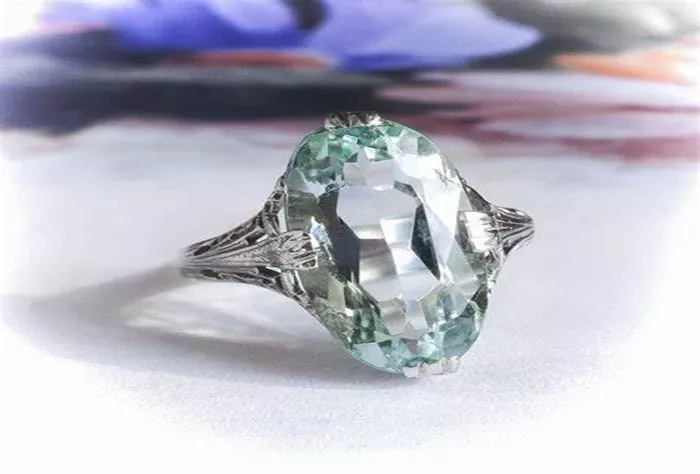Aquamarine jewelry holds a special place in the world of gemstones. Its soft blue-green hue evokes the colors of the sea, giving it a timeless appeal. The name “aquamarine” comes from the Latin words for “water” and “sea,” perfectly describing its tranquil beauty. Collectors and jewelry lovers prize antique aquamarine pieces for their history, craftsmanship, and rarity. Unlike modern gemstones, antique aquamarines often carry unique cuts and settings that reflect the styles of past eras.
The Origins and Characteristics of Aquamarine
Aquamarine is a variety of beryl, the same mineral family as emerald. However, unlike emeralds, which are known for their deep green tones, aquamarine ranges from pale blue to greenish-blue. The most valuable antique aquamarines display a clear, vivid blue color with minimal inclusions. In the past, gem cutters worked with the natural shape of the stone, creating hand-cut facets that differ from today’s precision cuts. These imperfections add character and prove the stone’s age and authenticity.
The Historical Significance of Aquamarine Jewelry
The history of aquamarine jewelry dates back centuries. Ancient civilizations believed the stone had protective powers, especially for sailors. Roman fishermen wore aquamarine amulets to ensure safe voyages. During the Middle Ages, people thought it could counteract poison and cure ailments. By the Victorian era, aquamarine became a popular choice for sentimental jewelry. Its delicate color symbolized youth, hope, and eternal happiness, making it a favorite for engagement rings and brooches.
Antique Aquamarine in Different Jewelry Periods
Antique aquamarine jewelry often features intricate metalwork. Victorian pieces, for example, commonly used yellow gold with elaborate engravings and floral motifs. Art Nouveau designers embraced aquamarine for its dreamy, ethereal quality, pairing it with flowing, nature-inspired designs. Edwardian jewelers preferred platinum and delicate filigree, enhancing the stone’s lightness. Each period left its mark on aquamarine jewelry, making antique pieces highly collectible today.
Famous Antique Aquamarines and Their Legacy
One of the most famous antique aquamarines is the Dom Pedro, a stunning obelisk-shaped gem weighing over 10,000 carats. While most antique aquamarines are smaller, they still carry immense charm. Georgian and Victorian rings often featured step-cut or rose-cut aquamarines, set in closed-back settings to enhance their color. Early 20th-century Art Deco pieces favored geometric designs with bold aquamarine accents. The variety of styles ensures that antique aquamarine jewelry appeals to different tastes.
How to Evaluate Antique Aquamarine Jewelry
When evaluating antique aquamarine jewelry, several factors matter. Color is the most important—deep blue stones command higher prices. Clarity also plays a role; older aquamarines may have slight inclusions, but they should not detract from the stone’s beauty. Cut and setting reveal the piece’s age and craftsmanship. Hand-finished details, such as milgrain edges or hand-engraved patterns, indicate true antique work. Provenance adds value if the piece has a documented history or connection to a notable figure.
Caring for Antique Aquamarine Jewelry
Caring for antique aquamarine jewelry requires gentle handling. Unlike harder gems like diamonds, aquamarine can scratch if not stored properly. Avoid harsh chemicals and ultrasonic cleaners, as they can damage the stone or its setting. Instead, clean antique pieces with mild soap and a soft brush. Regular inspections by a jeweler help maintain the integrity of older settings, which may have weakened over time.
The Market for Antique Aquamarine Jewelry
The market for antique aquamarine jewelry remains strong. Collectors seek pieces with historical significance, while others appreciate their romantic aesthetic. Auction houses and specialized dealers often feature antique aquamarine rings, necklaces, and brooches. Prices vary depending on age, condition, and design, but well-preserved pieces from renowned eras can fetch high sums. For those new to collecting, starting with smaller items like stickpins or earrings allows for appreciation without a major investment.
Why Antique Aquamarine Jewelry Endures
Modern jewelers sometimes replicate antique styles, but true antique aquamarine pieces have unmatched authenticity. The slight irregularities in hand-cutting, the patina of aged metal, and the wear from decades of use all tell a story. Whether as an heirloom or a personal treasure, antique aquamarine jewelry connects the wearer to the past. Its enduring beauty ensures it will remain cherished for generations to come.
Conclusion
In conclusion, antique aquamarine jewelry is a captivating blend of history, artistry, and natural beauty. Derived from the beryl mineral family, aquamarine’s unique blue – green hues have enchanted civilizations throughout time. With roots in ancient beliefs of protection and healing, it has evolved through different jewelry periods, each leaving its distinct mark on the design and craftsmanship. Famous specimens like the Dom Pedro exemplify the allure of these antique gems. When evaluating such pieces, color, clarity, cut, setting, and provenance are crucial factors. Gentle care is essential to preserve their integrity. The market for antique aquamarine jewelry thrives, appealing to collectors and enthusiasts alike. Its enduring charm lies in the authenticity that modern replicas cannot match, making it a timeless treasure that bridges the past and present, and will continue to be cherished for years to come.
Related Topics:
- Antique Aquamarine Gold Ring: Value, Identification & Care
- The Timeless Elegance of an Emerald Cut Aquamarine Ring with Diamonds
- The Emerald Aquamarine Ring: A Testament to Timeless Elegance


